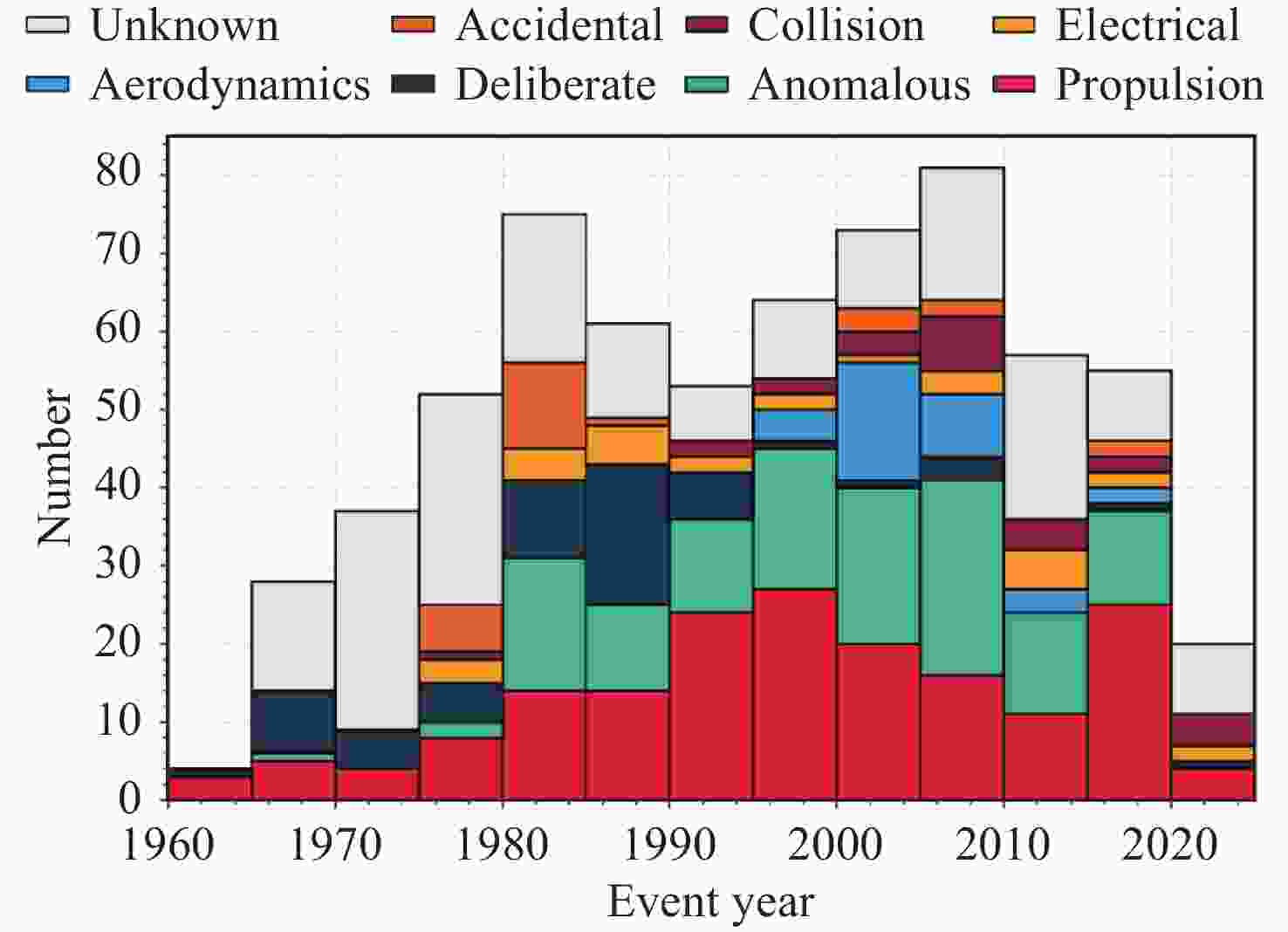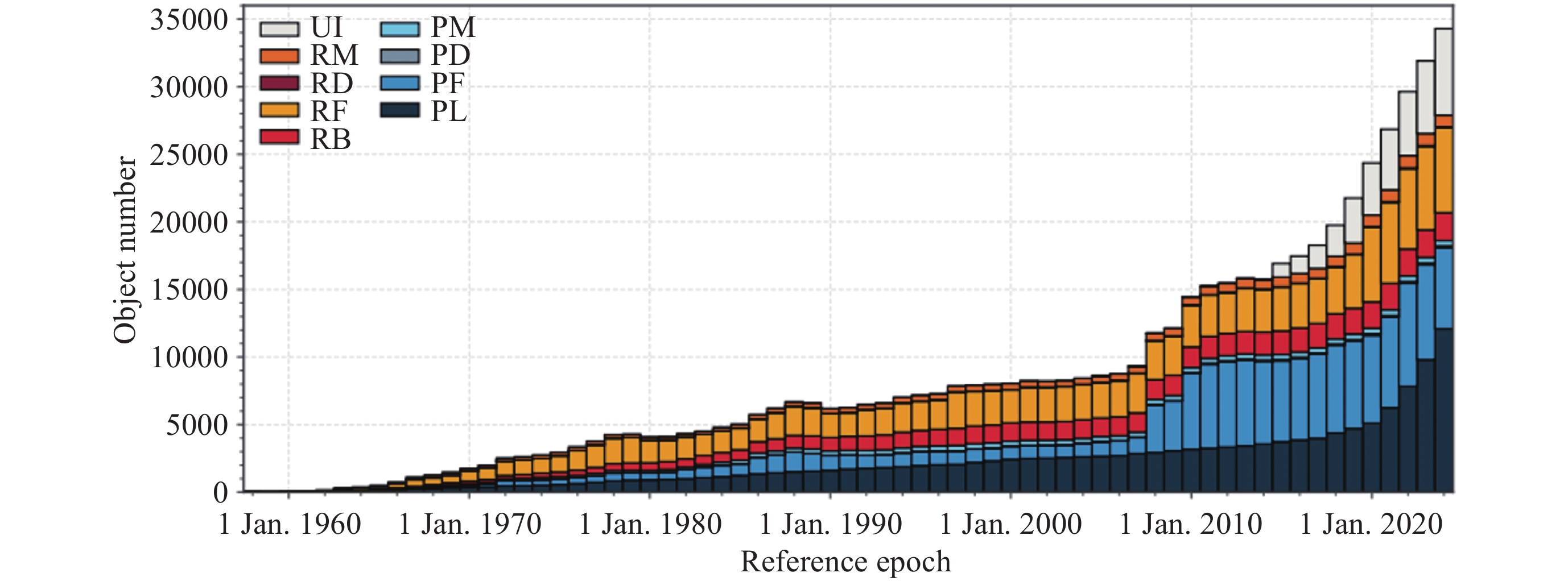Experimental Study on Short-arc Initial Orbit Determination of Space Debris Based on Commercial Space-based and Ground-based Electro-optical Monitoring Data
-
摘要: 随着国内空间碎片监测设备的不断增多, 如何有效利用大量观测数据以发挥商业航天的价值, 成为一个值得深入研究的重要课题. 利用中国商业航天公司的仰望一号天基观测数据和烛龙地基观测网的数据, 开展了地球同步轨道 (GEO) 目标和低地球轨道 (LEO) 目标的初轨确定 (IOD), 并通过两行轨道根数(TLE)作为已知值来估计初轨误差. 得到GEO目标的观测弧长约为249 s, 初轨半长轴误差为84.4 km, 倾角误差为0.40°; LEO目标的观测弧长约为40 s, 初轨半长轴误差为26.0 km, 倾角误差为0.13°. 结果表明, 本文采用的初轨确定算法是可行的, 并展示了商业航天领域中天地基光电监测设备的巨大潜力.Abstract: With the development of domestic commercial spaceflight and the increasing number of space debris monitoring equipment, how to make full use of the observed data from commercial spaceflight has become an important subject worthy of further study. Initial orbit determination of space targets is not only an important basis for space mission planning and space situational awareness, but also a prerequisite for key technologies such as satellite operations, collision warning, orbit maintenance, etc. This study uses data obtained from the Yangwang-1 space-based observatory system and the Zhulong ground-based observatory network developed by China’s commercial spaceflight companies to conduct Initial Orbit Determination (IOD) for Geosynchronous Earth Orbit (GEO) targets and Low Earth Orbit (LEO) targets, respectively. The Yangwang-1 satellite carries advanced electro-optical sensors that enable long duration, high precision continuous observations of GEO targets, while the Zhulong ground-based observation network consists of multiple electro-optical telescopes distributed at various locations across the country, capable of short arc, high frequency observations of LEO targets. In this study, we used the method of initial orbit determination based on optical goniometry observations, using the range searching method and iterative improvement strategy to estimate the initial orbits of GEO and LEO targets, and used Two-Line Element (TLE) data as a benchmark to evaluate the error of the calculated results. Experimental results show that for GEO targets, the observed arc length is about 249 s, the semi-major axis error determined by the initial orbit is 84.4 km, and the inclination error is 0.40°; For LEO targets, the observed arc is about 40 s, the semi-major axis error of the initial orbit is 26.0 km, and the inclination error is 0.13°. The results show that the method of initial orbit determination adopted in this study is feasible in the data processing of commercial spaceflight observations, and the great potential of space-based electro-optical monitoring equipment in the field of orbit determination is verified.
-
表 1 近几年初轨确定方法及其精度
Table 1. Initial orbit determination methods and their precision in recent years
方法 数据来源 精度统计 基于改进Gauss方程的初轨确定新方法[17] 仿真观测数据. LEO, MEO, HEO和GEO各一条数据, 弧段长度分别为15, 120, 160, 180 s, 并分别增加5″的随机误差 半长轴误差分别为50.0, 15.0, 55.0和2.0 km 光学短弧初轨确定的轨道偏心率判定方法[18] 仿真观测数据. LEO1和LEO2的弧段长度为120 s; MEO, HEO和GEO目标的弧段长度为240 s LEO1, MEO, GEO轨道半长轴误差的均方根(RMS)值分别为55.9, 46.6, 150.2 km, 倾角误差的RMS分别为0.18°, 0.05°, 0.14°. LEO2和HEO半长轴误差的RMS分别为86.9和419.5 km, 倾角误差的RMS分别为0.16°和0.90° 多约束初轨确定算法[19] 实测数据. 2021年5月15日中国科学院国家天文台长春人造卫星观测站的GEO目标观测数据 弧长大于60 s时, 误差小于200 km的占比为93.6%; 弧长小于60 s时, 误差小于200 km的占比为65.8% 表 2 GEO目标信息
Table 2. Information of GEO objects
目标编号 目标名称 发射时间 国家 近/远地点高度/km 27954 GALAXY 13 (HORIZONS-1) 2003-10-01 美国 35781.6/35806.4 42763 ZHONGXING-9 A 2017-06-18 中国 35912.1/35944.7 45344 BEIDOU-3 G2 2020-03-09 中国 35774.1/35813.9 表 3 GEO目标初轨确定文件及误差
Table 3. Initial orbit determination document and associated errors for GEO objects
序号 观测文件 弧长/s 误差 半长轴/km 偏心率 倾角/(°) 1 27954_1123062202.Dat 290 31.5 –0.00012 0.48 2 27954_1123062203.Dat 290 24.4 0.00026 0.55 3 27954_1123062204.Dat 275 25.5 –0.00007 0.52 4 42763_1123061711.Dat 90 –115.1 0.00077 0.11 5 42763_1123061712.Dat 210 –109.1 –0.00032 0.23 6 42763_1123061713.Dat 275 –112.6 –0.00055 0.42 7 42763_1123061714.Dat 255 159.9 –0.00046 0.69 8 42763_1123061715.Dat 185 –105.8 –0.00055 0.40 9 45344_1123061806.Dat 290 22.6 0.00006 0.23 10 45344_1123061807.Dat 290 24.2 0.00005 0.18 11 45344_1123061808.Dat 290 22.4 –0.00015 0.02 平均值 — 249 68.5 0.00031 0.35 表 4 LEO目标信息
Table 4. Information of LEO objects
目标编号 目标名称 发射时间 国家及机构 近/远地点高度/km 1328 EXPLORER 27 1965-04-29 美国 935.7/1305.6 41240 JASON-3 2016-01-17 美国 1339.2/1350.6 46984 SENTINEL-6 2020-11-21 欧洲航天局 1338.9/1350.8 47764 STARLINK-2182 2021-03-04 美国 390.7/392.5 48621 HAIYANG-2D 2021-05-19 中国 951.7/966.4 49414 STARLINK-3146 2021-11-13 美国 545.8/548.0 54754 SWOT 2022-12-16 美国 900.0/900.7 54777 STARLINK-5468 2022-12-17 美国 546.0/547.8 表 5 LEO目标初轨确定误差
Table 5. IOD errors of LEO objects
NORAD ID 弧段数量 弧长/s 轨道根数误差 半长轴/km 偏心率 倾角/(°) 1328 2 39 134.2 0.02213 0.12 41240 31 51 17.1 0.00187 0.10 46984 21 47 19.6 0.00202 0.12 47764 2 30 16.1 0.00215 0.02 48621 11 37 18.6 0.00158 0.14 49414 1 44 13.5 0.00255 0.08 54754 6 45 12.6 0.00236 0.14 54777 1 28 2.7 0.00206 0.03 平均值 9.4 40 29.3 0.00459 0.09 -
[1] NAPPER I E, DAVIES A J, JAH M, et al. Protect Earth’s orbit: avoid high seas mistakes[J]. Science, 2023, 379(6636): 990-991 doi: 10.1126/SCIENCE.ADG8989 [2] BOLEY A, BYERS M. U. S. policy puts the safe development of space at risk[J]. Science, 2020, 370(6513): 174-175 doi: 10.1126/science.abd3402 [3] BUCHANAN M. It’s time to tackle space debris[J]. Nature Physics, 2024, 20(5): 680 doi: 10.1038/S41567-024-02501-4 [4] LITTLE B D, FRUEH C E. Space situational awareness sensor tasking: comparison of machine learning with classical optimization methods[J]. Journal of Guidance, Control, and Dynamics, 2020, 43(2): 262-273 doi: 10.2514/1.G004279 [5] ESA. ESA’S Annual Space Environment Report[R]. ESA Space Debris Office, [2025-03-21] https://sdup.esoc.esa.int/discosweb/statistics [6] PELTON J N. A path forward to better space security: finding new solutions to space debris, space situational awareness and space traffic management[J]. Journal of Space Safety Engineering, 2019, 6(2): 92-100 doi: 10.1016/j.jsse.2019.04.005 [7] FANG Yong. Major trends and implications of space traffic management in the United States[J]. Space Debris Research, 2021, 21(1): 37-41 (方勇. 美国太空交通管理主要动向及影响[J]. 空间碎片研究, 2021, 21(1): 37-41FANG Yong. Major trends and implications of space traffic management in the United States[J]. Space Debris Research, 2021, 21(1): 37-41 [8] LEI Xiangxu, XIA Shengfu, LIU Hongkang, et al. Analysis of the first space debris collision avoidance event of Galileo satellite[C]//Proceedings of the 14th China Satellite Navigation Annual Conference—S03 Satellite orbit and precise positioning. Jinan: China Satellite Navigation Office Academic Exchange Center, 2024: 50-56. DOI: 10.26914/c.cnkihy.2024.000175 (雷祥旭, 夏胜夫, 刘宏康, 等. 伽利略卫星首次轨道机动规避空间碎片事件分析[C]//第十四届中国卫星导航年会论文集--S03卫星轨道与精密定位. 济南: 中国卫星导航系统管理办公室学术交流中心, 2024: 50-56. DOI: 10.26914/c.cnkihy.2024.000175LEI Xiangxu, XIA Shengfu, LIU Hongkang, et al. Analysis of the first space debris collision avoidance event of Galileo satellite[C]//Proceedings of the 14th China Satellite Navigation Annual Conference—S03 Satellite orbit and precise positioning. Jinan: China Satellite Navigation Office Academic Exchange Center, 2024: 50-56. DOI: 10.26914/c.cnkihy.2024.000175 [9] LEWIS H. Starlink manoeuvre update July 2024[EB/OL]. LinkedIn, 2024-07[2025-04-27] https://www.linkedin.com/pulse/starlink-manoeuvre-update-july-2024-hugh-lewis-vq4be [10] SHI Peng, BAI Qingjiang, WANG Qin, et al. Review of 2021 global space science activities[J]. Science :Times New Roman;">& Technology Review, 2022, 40(1): 64-95. DOI: 10.3981/j.issn.1000-7857 (时蓬, 白青江, 王琴, 等. 2021年空间科学与深空探测热点回眸[J]. 科技导报, 2022, 40(1): 64-95SHI Peng, BAI Qingjiang, WANG Qin, et al. Review of 2021 global space science activities[J]. Science & Technology Review, 2022, 40(1): 64-95. DOI: 10.3981/j.issn.1000-7857 [11] NIU Shu, SU Meng, ZHANG Xiaojia, et al. YangWang-1 space telescope space in-orbit comprehensive applications[J]. Space Debris Research, 2023, 23(2): 13-20. DOI: 10/19963/j.cnki.2096-4099.2023.02.002 (牛书, 苏萌, 张晓佳, 等. “仰望一号”太空望远镜在轨综合应用[J]. 空间碎片研究, 2023, 23(2): 13-20. DOI: 10/19963/j.cnki.2096-4099.2023.02.002NIU Shu, SU Meng, ZHANG Xiaojia, et al. YangWang-1 space telescope space in-orbit comprehensive applications[J]. Space Debris Research, 2023, 23(2): 13-20. DOI: 10/19963/j.cnki.2096-4099.2023.02.002 [12] TANG Jingshi, CHENG Haowen. Initial orbit determination using the generalized Laplacian method with differential correction and circular-orbit constraint[J]. Scientia Sinica Physica, Mechanica :Times New Roman;">& Astronomica, 2022, 52(6): 269511. DOI: 10.1360/SSPMA-2021-0224 (汤靖师, 程昊文. 基于微分改正和圆轨道约束的广义Laplace方法初轨确定[J]. 中国科学: 物理学 力学 天文学, 2022, 52(6): 269511. DOI: 10.1360/SSPMA-2021-0224TANG Jingshi, CHENG Haowen. Initial orbit determination using the generalized Laplacian method with differential correction and circular-orbit constraint[J]. Scientia Sinica Physica, Mechanica & Astronomica, 2022, 52(6): 269511. DOI: 10.1360/SSPMA-2021-0224 [13] VALLADO D A, MCCLAIN W D. Fundamentals of Astrodynamics and Applications[M]. 2nd ed. Boston: Kluwer Academic, 2001. DOI: 10.2514/2.4291 [14] GOODING R H. A new procedure for the solution of the classical problem of minimal orbit determination from three lines of sight[J]. Celestial Mechanics and Dynamical Astronomy, 1996, 66(4): 387-423 doi: 10.1007/BF00049379 [15] ZHANG Pin, SANG Jizhang, PAN Teng, et al. Initial orbit determination method based on range searching for LEO space debris[J]. Spacecraft Engineering, 2017, 26(2): 22-28 (章品, 桑吉章, 潘腾, 等. 应用距离搜索的低轨空间碎片初始轨道确定方法[J]. 航天器工程, 2017, 26(2): 22-28 doi: 10.3969/j.issn.1673-8748.2017.02.004ZHANG Pin, SANG Jizhang, PAN Teng, et al. Initial orbit determination method based on range searching for LEO space debris[J]. Spacecraft Engineering, 2017, 26(2): 22-28 doi: 10.3969/j.issn.1673-8748.2017.02.004 [16] XU Xiaoli, XIONG Yongqing. Study on orbit prediction error of space objects based on historical TLE[J]. Acta Astronomica Sinica, 2019, 60(4): 28-40 (许晓丽, 熊永清. 基于历史TLE的空间目标轨道预报误差演化规律研究[J]. 天文学报, 2019, 60(4): 28-40 doi: 10.15940/j.cnki.0001-5245.2019.04.003XU Xiaoli, XIONG Yongqing. Study on orbit prediction error of space objects based on historical TLE[J]. Acta Astronomica Sinica, 2019, 60(4): 28-40 doi: 10.15940/j.cnki.0001-5245.2019.04.003 [17] ZHAO Kexin, GAN Qingbo, LIU Jing. A new initial orbit determination method based on space-based three lines of sight[J]. Acta Astronomica Sinica, 2022, 63(5): 69-79 (赵柯昕, 甘庆波, 刘静. 利用3次方位观测天基初轨确定新方法[J]. 天文学报, 2022, 63(5): 69-79 doi: 10.15940/j.cnki.0001-5245.2022.05.005ZHAO Kexin, GAN Qingbo, LIU Jing. A new initial orbit determination method based on space-based three lines of sight[J]. Acta Astronomica Sinica, 2022, 63(5): 69-79 doi: 10.15940/j.cnki.0001-5245.2022.05.005 [18] ZHANG Zhengyuan, LI Bin, ZHAO Guangyu, et al. A method to determine orbit eccentricity determined from short-arc angles-only initial orbit determination[J]. Space Debris Research, 2023, 23(4): 46-55 (张郑元, 李彬, 赵广宇, 等. 一种光学短弧初轨确定的轨道偏心率判定方法[J]. 空间碎片研究, 2023, 23(4): 46-55 doi: 10.19963/j.cnki.2096-4099.2023.04.005ZHANG Zhengyuan, LI Bin, ZHAO Guangyu, et al. A method to determine orbit eccentricity determined from short-arc angles-only initial orbit determination[J]. Space Debris Research, 2023, 23(4): 46-55 doi: 10.19963/j.cnki.2096-4099.2023.04.005 [19] YIN Yewen, LI Zhenwei, LIU Chengzhi, et al. Initial orbit determination for GEO space objects based on ground-based optical telescopes[J]. Progress in Astronomy, 2024, 42(3): 506-518 (尹业文, 李振伟, 刘承志, 等. 基于地基光电望远镜的地球同步轨道卫星空间目标初轨确定研究[J]. 天文学进展, 2024, 42(3): 506-518 doi: 10.3969/j.issn.1000-8349.2024.03.07YIN Yewen, LI Zhenwei, LIU Chengzhi, et al. Initial orbit determination for GEO space objects based on ground-based optical telescopes[J]. Progress in Astronomy, 2024, 42(3): 506-518 doi: 10.3969/j.issn.1000-8349.2024.03.07 -
-





 劳振迪 男, 2000年9月出生于山东省滨州市, 现为山东理工大学硕士研究生, 主要研究方向为空间目标的机动探测、空间碎片监测. E-mail:
劳振迪 男, 2000年9月出生于山东省滨州市, 现为山东理工大学硕士研究生, 主要研究方向为空间目标的机动探测、空间碎片监测. E-mail: 

 下载:
下载:









